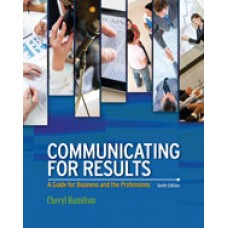Test Bank for Communicating for Results A Guide for Business and the Professions, 10th Edition
$35.00 Original price was: $35.00.$26.50Current price is: $26.50.
Test Bank for Communicating for Results A Guide for Business and the Professions, 10th Edition
This is completed downloadable of Test Bank for Communicating for Results A Guide for Business and the Professions, 10th Edition

Product Details:
- ISBN-10 : 1111842167
- ISBN-13 : 978-1111842161
- Author: Cheryl Hamilton
This best-selling text will show you the basic concepts and techniques you need to successfully communicate in today’s business world, regardless of your current level of business experience. Covering every aspect of the communication process, COMMUNICATING FOR RESULTS: A GUIDE FOR BUSINESS AND THE PROFESSIONS, Tenth Edition, will give you a competitive edge in any business situation–from the initial interview to making skilled presentations (complete with professional visual aids) to assuming a leadership role. In addition, you’ll find online video clips of common professional scenarios paired with the concepts from the text give you a realistic glimpse into the business world. COMMUNICATING FOR RESULTS: A GUIDE FOR BUSINESS AND THE PROFESSIONS, Tenth Edition, is your opportunity to see how theory translates into practical action–and how that knowledge will help you improve your chance of career success!
Table of Content:
- Unit 1: Understanding Communication in the Workplace
- Analyze This Real-Life Case
- Ethics Choices and Communication Challenges
- Reflect and Respond
- Chapter 1: Communication and Ethics at Work: What Should You Know?
- Opening Thoughts
- Communication Defined
- Models of Communication: An Overview
- One-Way Model
- Circular Model
- Transaction Model
- The Basic Transaction Model Expanded
- Person A/Person B
- Stimulus and Motivation
- Encoding and Decoding
- Frame of Reference
- Code
- Channel
- Feedback
- Environment
- Noise
- Polishing Your Career Skills: How Skilled a Communicator Are You?
- How Communication Flows in Organizations
- Informal Communication
- Formal Communication
- Communication and Ethics
- Collaborative Learning Activities
- Chapter 2: Organizations In the Workplace: Which Ones Fit You Best?
- Opening Thoughts
- Organizations: Before You Commit to a Job, What Should You Know?
- Types of Organizations
- The Traditional (or Classical) Organization
- The Human Relations Organization
- The Human Resources Organization
- Polishing Your Career Skills: Which Type Organization Fits Me Best?
- The Systems/Contingency Organization
- The Transformational Organization
- How Each Type Organization Uses Communication
- How Organizations Coordinate People and Groups
- Collaborative Learning Activities
- Chapter 3 Handling Conflict, Cultural Diversity, and Relationships
- Opening Thoughts
- Handling Conflicts in the Workplace
- Conflict Types
- Conflict Strategies
- Choosing the Best Conflict Strategies
- Reaching Consensus in Conflict Management
- Cultural Differences in the Workplace
- Individualistic and Collectivistic Cultures
- High-and Low-Context Cultures
- Monochronic and Polychronic Cultures
- Cultural Differences and Conflict
- Interpersonal Relationships in the Workplace
- Keys to Building and Maintaining Relationships
- Relationships and Styles In the Workplace: An Overview
- Communication Styles: What Are They
- Important Tips On Using Communication Styles In the Workplace
- Becoming Flexible In Use of Styles
- Communication Styles: Polishing Your Career Skills
- Polishing Your Career Skills: What Is Your Communication Style? Survey Short Form
- Polishing Your Career Skills: What Is Your Communication Style? Survey Long Form
- Collaborative Learning Activities
- Unit 2: Personalizing Communication in the Workplace
- Analyze This Real-Life Case
- An Engineer’s Experience with Communication and Listening
- Reflect and Respond
- Chapter 4: Effective Listening
- Opening Thoughts
- Effective Listening in the Workplace
- Polishing Your Career Skills: How Skilled a Listener Are You?
- Listening to Customers
- Listening to Employees
- Listening to Supervisors
- Listening to Coworkers
- Signs of Poor Listening
- Breaking the Chain of Command
- Learning about Events Too Late
- Always Putting Out Fires
- Information Must Be Repeated
- Tasks Given to Others
- Increase in Written Communication
- Increase in Poor Listening Habits
- Barriers to Good Listening
- Physical Barriers
- Personal Barriers
- Gender Barriers
- Age/Generational Barriers
- Semantic Barriers
- Technology Barriers
- Listening Skills: Improvements Lead to Payoffs
- Understanding the Stages of Listening
- Improving Your Listening—Key Points
- Payoffs of Effective Listening
- Collaborative Learning Activities
- Chapter 5: Nonverbal Communication
- Opening Thoughts
- Nonverbal Communication: Definition, Culture, and Principles
- Technical Level
- Formal Level
- Informal Level
- Types of Nonverbal Communication and Their Effects on Business Communication
- Facial Expressions and Eye Contact
- Body Movements, Posture, and Gestures
- Touch
- Clothing and Personal Appearance
- Polishing Your Career Skills: Does Nonverbal Communication Work for You or Against You?
- Distance and Personal Space
- Physical Environment
- Time
- Status Symbols
- Signs of Power
- Signs of Weakness
- Nonverbal Messages and International Business Transactions
- Mistakes and Culture Shock
- Improving Nonverbal Skills
- Expectancy Violations Theory
- Immediacy Behaviors
- Creating Effective Habits
- Collaborative Learning Activities
- Chapter 6: Anxiety, Technology, and Other Communication Obstacles
- Opening Thoughts
- Anxiety as a Communication Obstacle
- Situational Anxiety
- Managing Situational Anxiety
- Trait Anxiety
- Managing Trait Anxiety with Positive Imagery
- Mastering Anxiety with Additional Methods
- Technology as a Communication Obstacle
- Technology and Social Media Statistics
- Social Media as an Obstacle in the Workplace
- Using Social Media to Turn Contacts into Relationships
- Making Your Social Media Resume Stand Out
- Building a Social Media Profile on Linkedin
- Other Forms of Media/ Technology as Communication Obstacles
- Polishing Your Career Skills: How Ready Are You to Leverage the Power of Social Media?
- Other Communication Obstacles
- Vague Instructions
- Jumping to Conclusions
- Bypassing
- Sexual Harassment
- Collaborative Learning Activities
- Unit 3: Maximizing Communication in the Workplace
- Analyze This Real-Life Case
- Amazon: Hiring Practices That Continue to “Raise the Bar”
- Reflect and Respond
- Chapter 7: Basic Information For All Types of Interviews
- Opening Thoughts
- Types of Interviews
- Counseling Interview
- Employment Interview
- Exit Interview
- Grievance, or Confrontation, Interview
- Group Interview
- Informational Interview
- Interrogation Interview
- Performance Review
- Persuasive Interview
- Telephone or Skype Interview
- Basic Interview Organization
- Opening Phase
- Question–Response Phase
- Closing Phase
- Using Questions Effectively in the Interview
- Determine the Types of Questions to Ask
- Decide How to Best Organize Questions
- Be Prepared to Answer Questions Effectively
- Polishing Your Career Skills: How Much Do You Know About Interview Questions?
- Collaborative Learning Activities
- Chapter 8: The Employment Interview
- Opening Thoughts
- Interviewee: Preparing For the Job Hunt
- Investigate the Employment Market
- Locate Specific Jobs of Interest
- Prepare a Resume: Conventional, Electronic, Web, or Social Media
- Check Resume Content For Accuracy and Honesty
- Prepare a Letter of Application or Cover Letter
- Interviewee: Preparing For the Interview
- Have a Positive Attitude
- Communicate and Dress For the Occasion—Impression Management
- Be Prepared For Any Type of Interview
- Polishing Your Career Skills: How Well Do You Communicate During An Interview?
- Carefully Plan Answers to Probable Questions
- Be Prepared With Questions to Ask the Interviewer
- Be Prepared to Follow Up the Interview
- Send a Thank-You Card
- Interviewer: Planning the Interview
- Get to Know the Interviewee Ahead of Time
- Plan the Environment
- Organize the Interview Carefully
- Interviewer: Conducting the Interview
- Ask Only Lawful Questions
- Listen Carefully to the Interviewee
- Collaborative Learning Activities
- Chapter 9: Small-Group Communication and Problem Solving
- Opening Thoughts
- Definition of a Small Group
- Use and Value of Teams In the Effective Organization
- Characteristics of Effective Problem-Solving Teams
- Effective Teams Are Well Prepared and Organized
- Effective Teams Receive Periodic Training
- Effective Teams Examine Assumptions and Opinions
- Effective Teams Evaluate Solutions By Comparing Them to Criteria and Consequences
- Effective Teams Avoid Groupthink
- Effective Teams Manage Cultural Diversity
- Effective Teams Can Operate Virtually
- The Basic Problem-Solving Procedure
- Step 1: Define the Problem
- Step 2: Research and Analyze the Problem
- Step 3: Establish a Checklist of Criteria
- Step 4: List Possible Alternatives
- Step 5: Evaluate Each Alternative
- Step 6: Select the Best Alternative(s)
- Polishing Your Career Skills: How Ready Are You For Teamwork
- Collaborative Learning Activities
- Chapter 10: Participation and Leadership in Teams
- Opening Thoughts
- Effective Team Participants Have Good Communication Skills
- Effective Team Participants Perform Needed Task and Maintenance Functions
- Task and Maintenance Functions
- Dysfunctional Behaviors
- Polishing Your Career Skills: How Well Do You Handle Task and Maintenance Functions in Groups
- Effective Team Leadership
- Trait Approach to Leadership
- Function Approach to Leadership
- Leadership Styles or Three-Dimension Approach to Leadership
- Situational Contingency Approach to Leadership
- Situational Leadership Approach
- Transformational Leadership Approach
- Leader Responsibilities
- Virtual Meetings
- Face-to-Face Meetings
- Collaborative Learning Activities
- Unit 4: Polishing Oral and Written Communication in the Workplace
- Analyze This Real-Life Case
- Harry Markopolos: Why Didn’t Anyone Heed His Warnings About Madoff?
- Reflect and Respond
- Chapter 11: Informative Presentations: Plan, Research, Organize, and Deliver
- Opening Thoughts
- Informative Presentations: Planning
- Informative versus Persuasive Presentations
- Types of Informative Presentations
- Audience Analysis
- Topic Selection
- Informative Presentations: Researching
- Why and What to Research
- Where to Research
- How to Avoid Plagiarism When Researching
- Informative Presentations: Organizing
- Organizing the Body of the Presentation
- Organizing the Introduction of the Presentation
- Organizing the Conclusion of the Presentation
- Adding Transitions to the Presentation
- Informative Presentations: Delivery
- Methods of Delivery
- Polishing Your Career Skills: Informative Presentations— Are You Ready?
- Characteristics of Effective Delivery
- Maintaining a Confident and Exciting Delivery
- Collaborative Learning Activities
- Chapter 12: Verbal and Visual Supporting Materials
- Opening Thoughts
- Verbal Supporting Materials
- Explanations
- Comparisons
- Illustrations
- Examples
- Statistics
- Expert Opinions
- Citing Sources of Supporting Materials
- Visual Supporting Materials
- Benefits of Using Visuals
- Types of Visual Aids
- Selecting Your Visual Aids
- Designing Your Visual Aids
- Sample Text and Graphic Visuals
- General Design Principles
- Tips For Using Color
- Using Microsoft Powerpoint
- Polishing Your Career Skills: Can You Prepare Effective Visual Aids?
- Collaborative Learning Activities
- Chapter 13: Persuasive Presentations: Individual or Team
- Opening Thoughts
- Persuasive Presentations: Definitions and Types
- Persuasion Defined
- Types of Persuasive Presentations
- Persuasion In Business
- Persuasive Presentations: Research Findings and Practical Application
- Persuasive Factor #1: Evidence and Logic of the Message
- Persuasive Factor #2: Credibility of the Speaker
- Persuasive Factor #3: Psychological Needs of the Listeners
- Persuasive Factor #4: Opinions of Key Listeners
- Persuasive Presentations: Preparation Steps
- Step 1: Analyze Your Expected Listeners and Their Needs
- Step 2: Write Your Exact Purpose As a Position Statement
- Step 3: Determine Your Initial Credibility and Plan to Increase It If Necessary
- Step 4: Research Your Topic and Choose the Best Method For Presenting Evidence to This Audience
- Step 5: Select the Best Pattern For Organizing Your Persuasive Speech
- Step 6: Prepare An Outline to Polish Verbal and Visual Supports, Introduction, and Conclusion
- Step 7: Review Your Presentation to Ensure It Is Ethical
- Step 8: Practice Your Presentation to Gain Confidence
- Polishing Your Career Skills: Persuasive Presentations—Are You Ready
- Team Presentations
- Characteristics of Effective Team Presentations
- Types of Team Presentations
- Content of Team Presentations
- Effective Team Delivery
- Collaborative Learning Activities
- Chapter 14: Written Communication
- Opening Thoughts
- Effective Written Communication
- Adapts to the Audience
- Makes a Good First Impression
- Is Effectively Organized: Proper Clarity and Length
- Looks Professional: Proper Formatting and Typeface
- Includes Accurate Sources— No Plagiarism, Distortion, or Exaggeration
- Writing Successful Email Messages
- Writing Successful Twitter Messages
- How to Get Started
- What Is a Twitter Message
- Why Would a Company Want to Use Twitter
- Twitter Basics
- Polishing Your Career Skills: How Effective Are Your Tweets
- Writing and Producing Videos
- Writing Skills Needed to Make Great Videos
- Technology Needed to Make Great Videos
- Writing a Successful Letter
- The Thank-You Letter
- The Follow-Up Letter
- Writing an Effective Resume
- Effective Resumes Grab Immediate Attention
- Effective Resumes Are Easy to Read
- Effective Resumes Provide More Than Basic Information
- Writing Informative Reports
- Types of Informative Reports
- Tools to Aid Understanding
- The Role of Outlines In Planning Informative Reports
- Finalizing Informative Reports
- Writing Persuasive Reports
- Organization of Persuasive Reports
- The Role of Outlines in Planning Persuasive Reports
- Finalizing Persuasive Reports
- Collaborative Learning Activities
- Answers to Awareness Check Quizzes
- References
- Author Index
- Subject Index
People Also Search:
communicating for results a guide for business and the professions
communicating for results a guide for business and the professions test bank download pdf
communicating for results a guide for business and the professions download scribd
Related products
Test Bank
Test Bank for Operating Systems: Internals and Design Principles, 7th Edition: William Stallings
Test Bank
Test Bank for Decision Support and Business Intelligence Systems, 9th Edition: Efraim Turban











